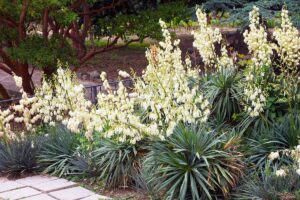Stenocereus thurberi
Icon of the southwest, organ pipe cactus (Stenocereus thurberi) is one of the best known species of cacti in the United States.
Reaching up to 26 feet in height and 12 feet wide, this slow-growing, long-lived sun lover can be truly enormous.
Tough, tenacious, and armed to the teeth, this cactus is the perfect example of evolution’s elegant engineering.

We link to vendors to help you find relevant products. If you buy from one of our links, we may earn a commission.
Given scarce water, organ pipe can expand its stems and store water internally. In the blistering heat of its native range, this cactus protects itself with tough skin and bristling spines.
To keep its fragile flowers protected from the hot sun, S. thurberi blooms at night when it can also take advantage of the region’s pollinating bats.
Although this cactus is tailor-made for Mexico and the American Southwest’s harshest landscapes, northern gardeners, don’t despair!
Given plenty of sunlight and heat, some low-nutrient soil, and just a little water, organ pipe can be grown in a pot.
And for southern gardeners, given the right conditions, this cactus can thrive in gardens there, too.
Here’s a quick preview of everything you’ll learn as you read along:
What You’ll Learn
What Is Organ Pipe Cactus?
A member of the Cactaceae, or cactus family, the organ pipe cactus bears all the hallmarks of this spiny, spiky, desert-dwelling group.
Growing from a low trunk, it promptly branches out into tall, leggy stems, which look more like arms, or even tentacles, to us.
It’s this multi-limbed appearance that makes S. thurberi, with a bit of imagination, look like a multi-piped church organ and that gives it its common name.
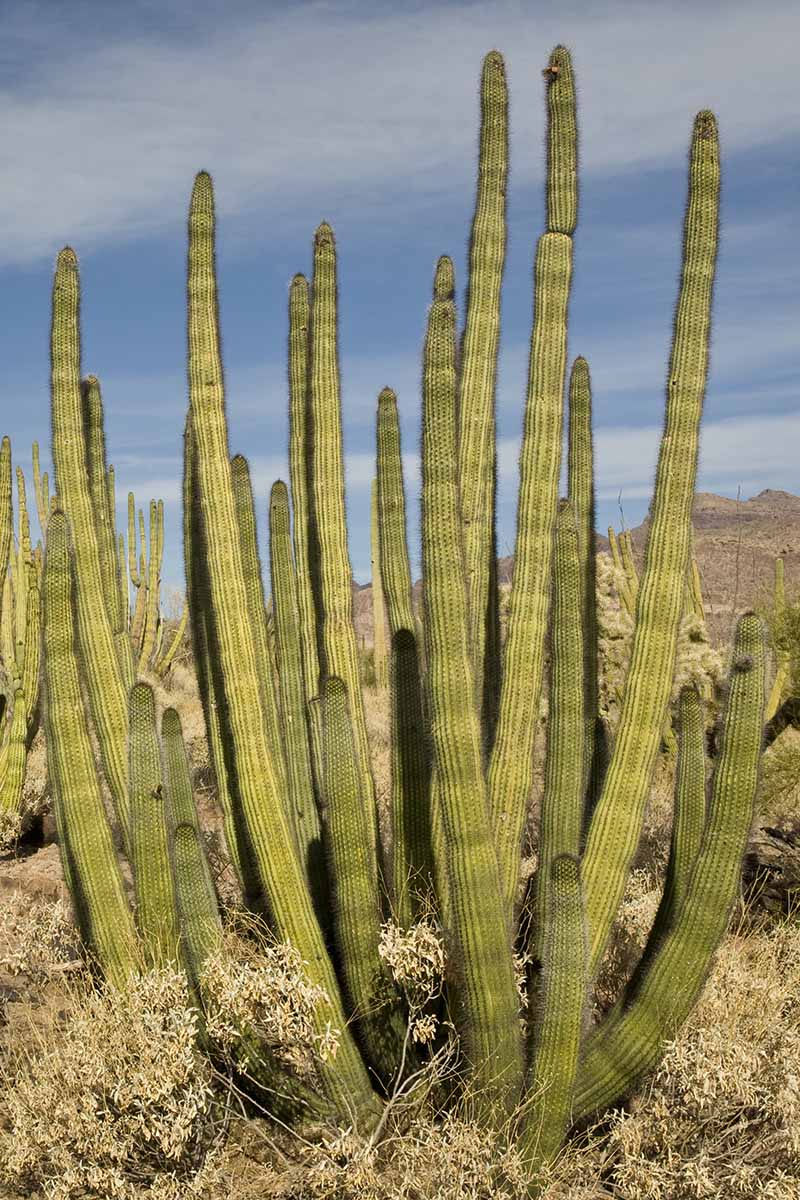
The cactus’s common name in Spanish, pitaya dulce, is a nod to the sweet and juicy fruit, which – once you get past the needle-sharp spines – is juicy and saccharine. It tastes almost like watermelon.
Once the round fruit is ripe, it splits open to reveal red flesh and glossy, dark seeds. In the wild, these little propagules are disseminated far and wide by pack rats and other small animals.
Preceding the cactus’s edible fruit is the flower.
Tubular and pale purple to white in color, the blossoms come once a year during the rainy season. These are pollinated by bats and close once the hot sun rises.
Cultivation and History
Somewhat finicky about its climatic preferences, this cactus’s native range is relatively small.
In the United States it can only be found growing close to the Mexican border and almost exclusively within Organ Pipe National Monument lands in southwestern Arizona.
In Mexico, it grows in the northwest portion of the country.
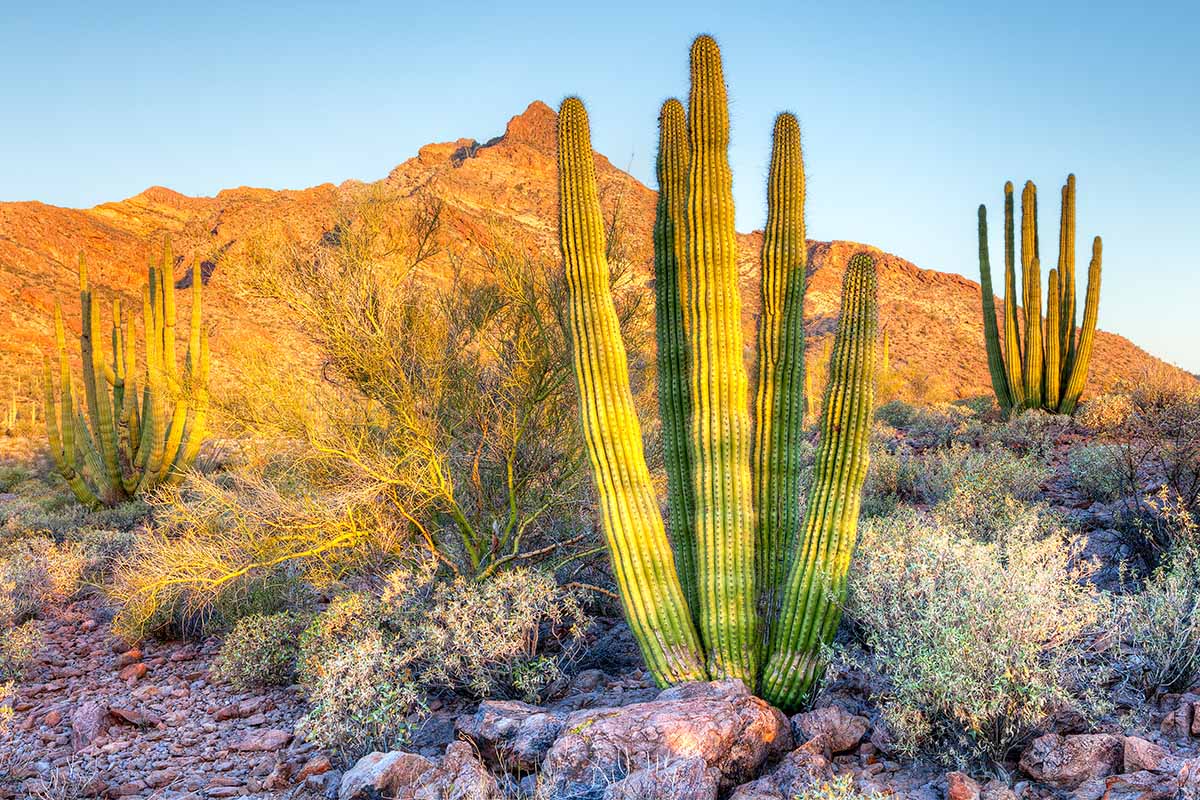
Tolerant of light frost, but intolerant of hard freezes, almost all cacti in the northern part of this species’ range bear evidence of cold weather damage.
Evident as lumps and bumps in their otherwise straight stems, frost damage can be prevented by covering the plant’s tender growing tips with something like a cup or sheet. Heck, get creative!
If you are growing S. thurberi outside of the recommended USDA Hardiness Zones 9 to 11, make sure you plant it either in a pot or against a wall, large rock, cliff, or other structure that can radiate heat at night and protect it from frost.
Despite its disdain for southwestern winters, some attempts have been made to commercialize the sweetly cloying fruit in the US.
As most of the organ pipe cactus population is protected within Arizona’s national monument reserve, these attempts have mostly failed. The fruit is seasonably available in Mexico, however, where it’s used to make juices, candies, and more.
The fruit and wood of this species has historically been of tremendous significance to local native people living in the area. These groups used the fruit for sustenance and the wood for making fires.
Interestingly enough, the fossil record suggests the organ pipe cactus is a relative newcomer to the United States. About 3,500 years ago, as the climate gradually warmed, this cactus was able to leave the dry tropics and stake a claim in the Sonoran Desert.
Organ Pipe Cactus Propagation
It may seem a little intimidating to cultivate such a unique plant at home, especially one with relatively narrow growing parameters, but I assure you it can be done!
From Seed
If you’re a cactus-growing rookie, cultivating S. thurberi from seed is not the method you’ll want to try first. If you have a little experience and want to give it a whirl, remember: when it comes to growing any kind of cacti, potting substrate is everything.
Start with a gritty, freely-draining potting soil specifically made for cacti. It should have a higher concentration of sand, pumice, gravel, perlite, or other additives that mimic the arid conditions of desert soils than your standard potting soil.
We have a DIY cactus potting mix recipe here.
Soak your little seeds for 24 hours prior to planting to encourage germination.
Plant two to three seeds on the surface of the soil in a four-inch pot. Next, cover the seeds with a very fine layer of grit.
The purpose of the grit is to hold the seed down so it doesn’t wash away with watering, not to cover the seeds completely. This species needs light to germinate.
Drench the soil thoroughly like a desert monsoon.
Place the pot in strong, indirect light where it will stay warm – think 80 to 90°F during the day, and about five to 10 degrees cooler at night. These seeds need warm temperatures for germination.
Spray the surface of the soil regularly with water so the seeds don’t dry out as they germinate. Germination should happen within a week or two.
Finally, and most importantly, have a little patience. Beyond germination, organ pipe is a notoriously slow grower, and conjuring this prickly plant from seed will take some time.
In about a year, you should have a teeny-tiny organ pipe cactus to transplant into a larger pot, or a suitable location outside. Make sure to water your young plant liberally, but infrequently, as it grows.
In about 35 years, you can look forward to your first bloom, if you can wait that long.
From Cuttings
Growing organ pipe from a cutting will yield a larger plant more quickly than starting from itty-bitty seeds.
Propagating cacti from cuttings can still be a challenging prospect for the novice gardener, so be prepared to stay alert for pests and disease as your little cactus grows.
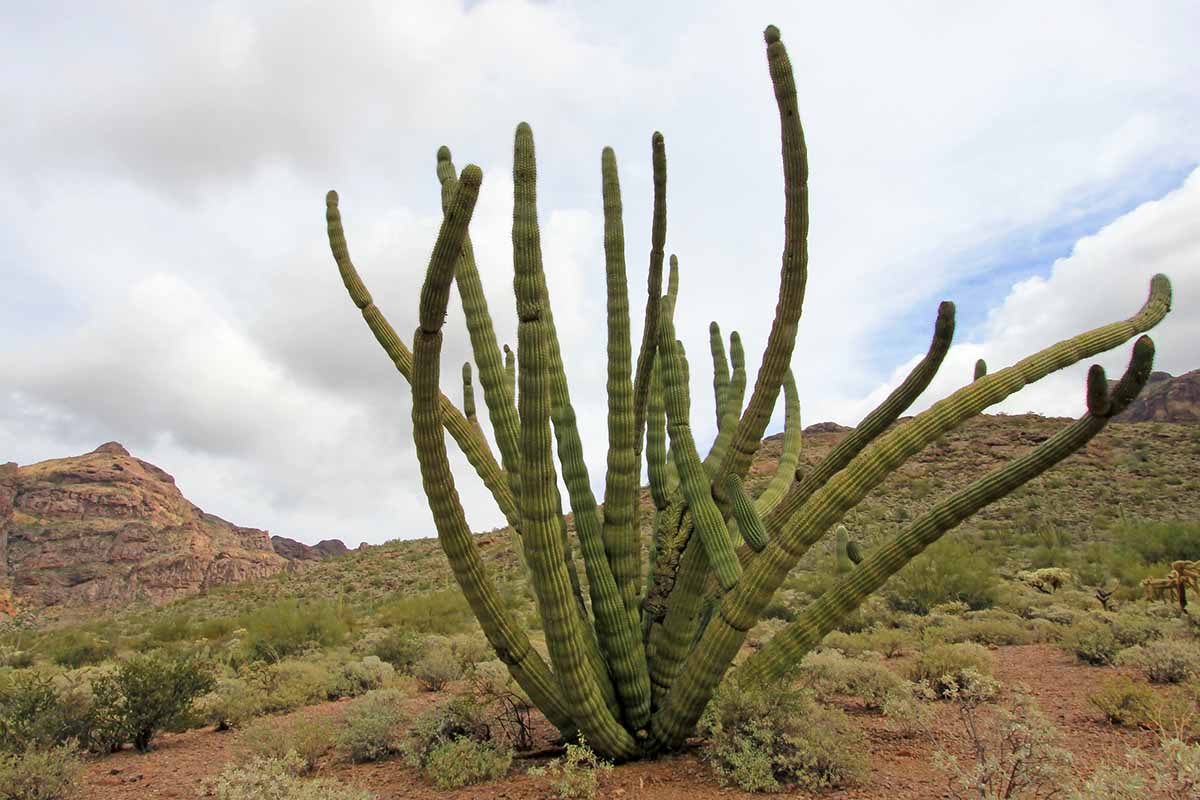
Cactus cuttings grow best and most quickly when taken in the spring, but this can be done successfully at any time of year.
To grow organ pipe from a cutting, select a healthy, straight stem and cut approximately four inches off the growing tip using a very sharp, clean knife. Make the cut at a 45-degree angle to protect the stem of the parent plant from rot.
Allow the cutting to form a callus over the cut bottom. The newly severed part of the cactus will harden and turn grayish brown. This typically takes a few days.
Press the cutting firmly into cactus potting soil so that it stands up on its own. Water well.
Place in full sun in a warm location. Do not cover with a plastic tent. Maintain dry, warm conditions to help prevent the cactus from rotting while it grows.
It will take about a month for small roots to form. Water well, but infrequently, about once a week.
From Seedlings/Transplanting
As ever, the most failsafe way to get a new plant growing in your garden or home is to buy one that’s already established.
S. thurberi is a relatively unfussy pot dweller and it has only a few basic requirements for growing indoors.
Make sure to transplant your newbie to a bigger pot with fresh cactus potting soil once you bring it home. Organ pipe cactus, along with most other cacti, appreciates an unglazed ceramic pot that will aid with drainage.
Learn more about pot and planter materials in our guide.
Water your cactus deeply, but infrequently. Approximately once a week should do it, but organ pipe will require even less moisture in the cooler, darker months of winter.
Always do a finger test before watering and make sure you feel that the soil has completely dried out first before watering again.
Place your cactus in the sunniest spot you’ve got. These plants ideally need a full eight hours of sun each day.
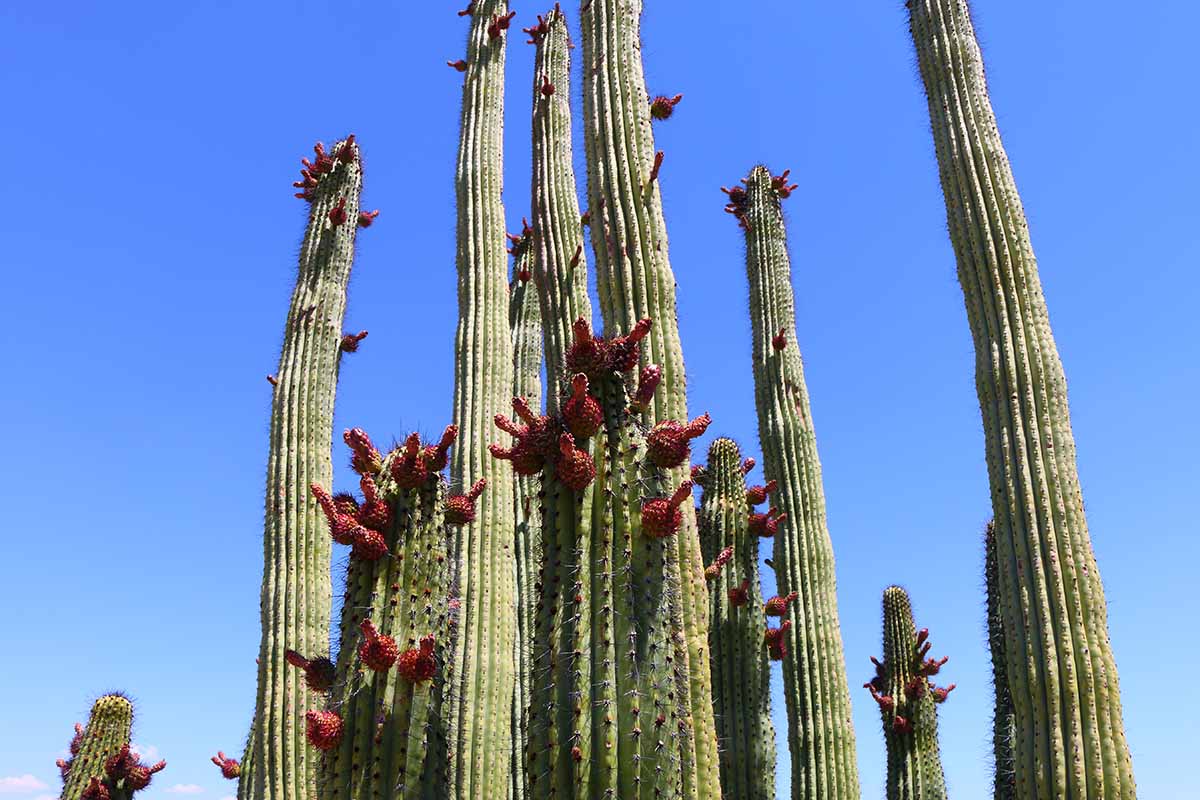
If planting in the garden, make sure you’re in USDA Zones 9 to 11. Otherwise, you’re probably setting yourself up for disappointment.
In Zone 8, if you have a well-protected outdoor area up against a wall or large rock, you’re eligible to trial organ pipe outdoors, but make sure to protect it with a sheet or frost cloth if a hard frost is forecast.
Select a spot in full sun, with plenty of room to grow. Remember, these giants can get taller than 20 feet, given time.
Finally, make sure to amend the soil if necessary to ensure it is gravely, sandy, and freely draining. These cacti easily suffer from root rot if planted in soils that are too rich in organic matter, too deep, too wet, or too loamy.
Learn more about propagating cacti in our guide.
How to Grow Organ Pipe Cactus
In general, organ pipe cactus needs a little help through the fragile baby stage.
Beyond that, this species is robust and adaptable, as long as its basic growing conditions are met. So choose a sunny, warm spot and back away from that watering can!
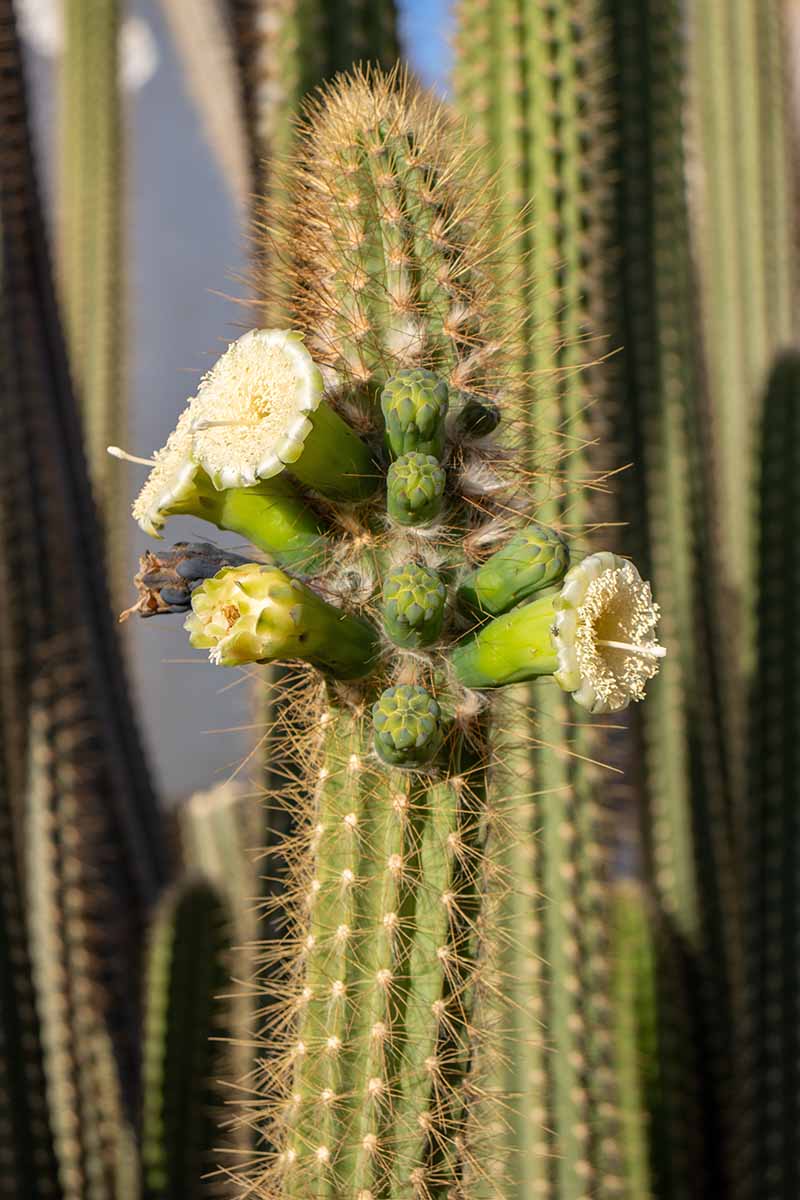
Arid conditions, plenty of sunlight, and adequate heat are the triumvirate of requirements for thriving, happy organ pipes. This means site selection is everything.
Don’t ever forget that this plant is suited for USDA Zones 9 to 11.
If you live in Vermont, your organ pipe is destined to be a greenhouse dweller. If you’re in Arizona, choose a sheltered spot in the garden and get growing.
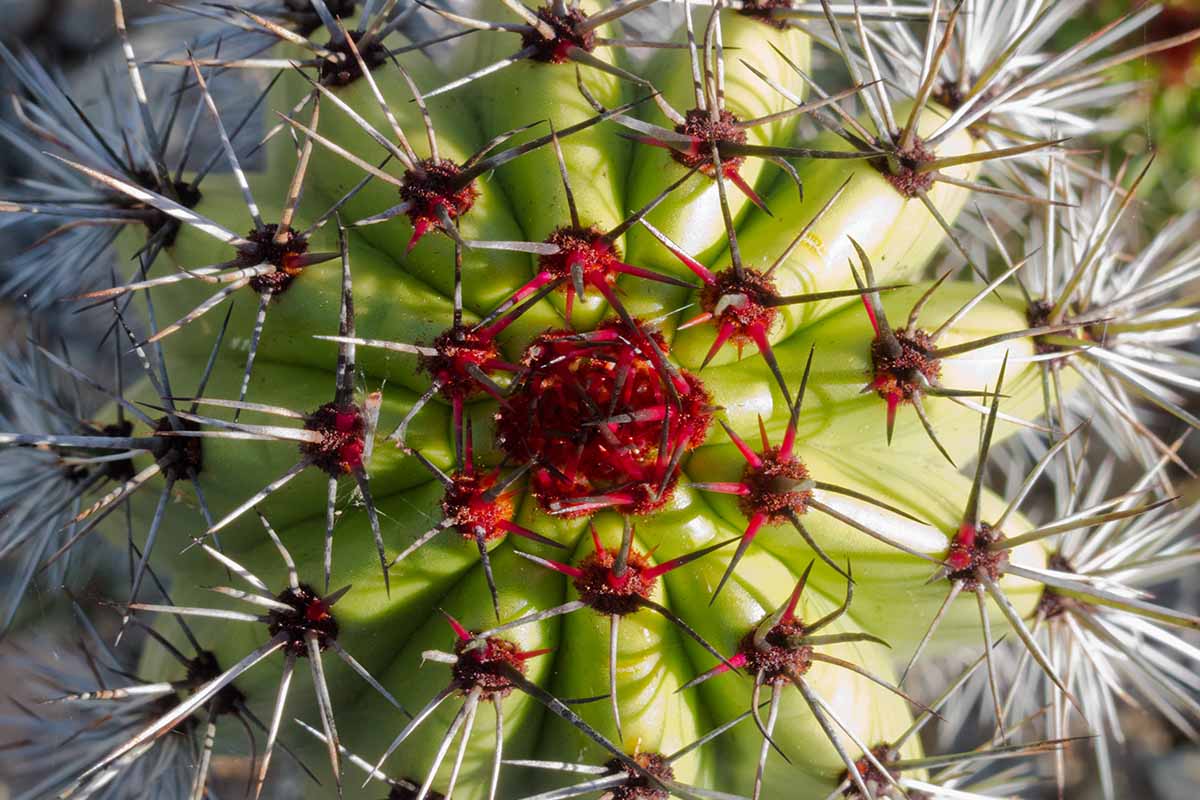
Like most other types of cacti, this species need only be watered sparingly, and infrequently.
At a maximum, you should water once a week. Make sure you let the soil dry out completely before watering, over the course of a week or two.
In more humid environments with plentiful rain, organ pipe should be grown in an unglazed ceramic pot to encourage drainage and prevent root rot.
If growing yours inside and the air is consistently humid, consider running a dehumidifier.
Fertilization is not necessary for this unfussy lover of gritty, low-nutrient soils when grown outside.
Growing Tips
- Site in a warm location where the temperature will not drop below 45°F.
- Shelter against a wall, large rock, or other structure in climates prone to frost.
- Plant in full sun.
- Once established outdoors, water only in dry spells.
Maintenance
Once established, organ pipe requires little maintenance save occasional watering.
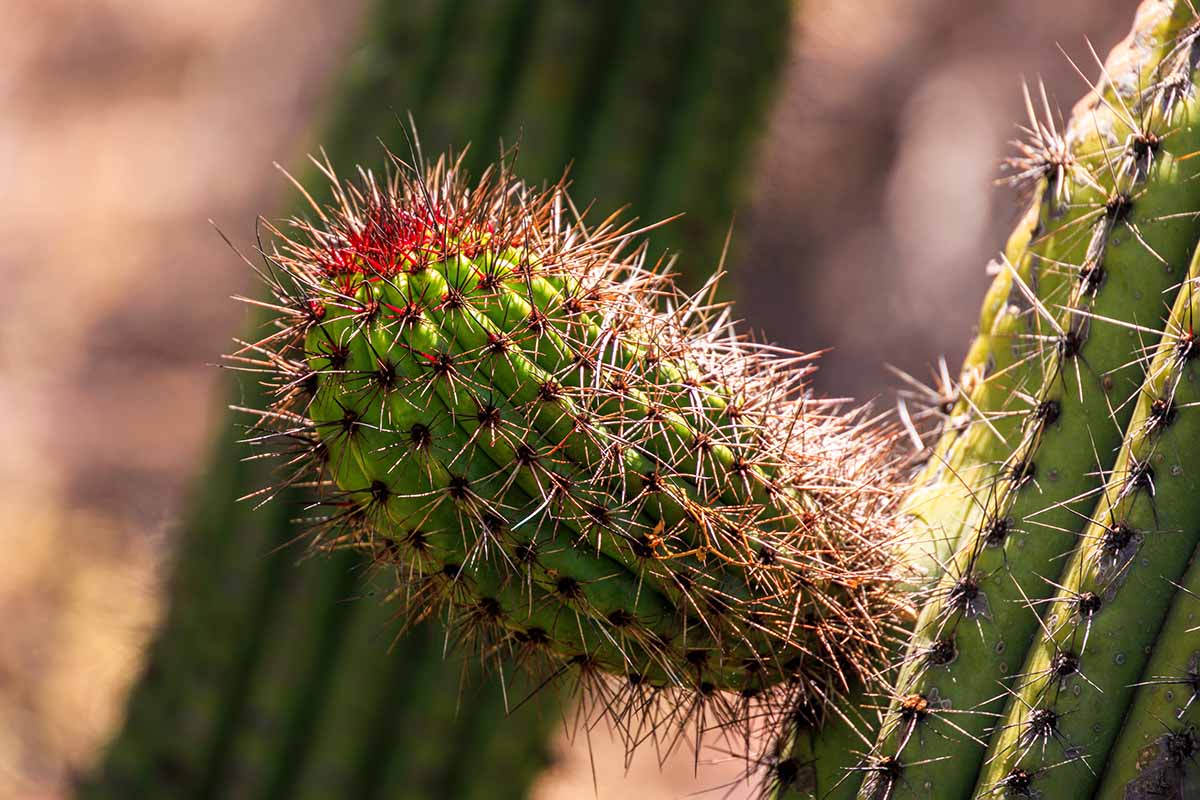
Cacti in pots will need watering approximately once a week, and feeding once a year in spring with a diluted solution of 5-10-5 NPK houseplant fertilizer. Make sure to dilute any liquid fertilizer given to half strength.
No pruning is required, however, this cactus does occasionally shed limbs which can be cut off and composted.
Where to Buy
Although organ pipe cactus is a relatively popular succulent for the home and garden scene, sourcing a larger sized specimen can be tricky.
Try calling around to bigger nurseries in metropolitan areas, or ask at a local botanical garden for intel.
Many gardens have a cactus house with a knowledgeable gardener who can give you the inside scoop.
If all else fails, you may be able to source seed online.
Managing Pests and Disease
Virtually pest- and disease-free in its natural environment, organ pipe is as tough as they come.
Outside of the hot desert conditions of the southwest and Mexico, however, excess moisture and cold can weaken plants and cause problems.
Herbivores
Unsurprisingly, there’s not a herbivore in existence that can make it past the fearsome spines once the cactus is old enough to wield them.
Armed to the teeth, this plant knows how to protect its hard won moisture and food.
Insects and Arachnids
Mercifully pest free, the organ pipe has few bugs that plague it.
When grown in a pot, particularly indoors in overly moist environments, the occasional beasty can take up residence on newer growth.
Mealybugs
Squishy, spidery, unsavory things, mealybugs are lovers of warm, humid environments and stressed-out plants.
To relieve your cactus of an infestation, spray the mealybugs and their white, cottony egg masses with a strong stream of water. Use a cotton ball dipped in 70 percent isopropyl alcohol to wipe off the ones you missed.
Plug in a dehumidifier to reduce moisture in the air indoors, and make sure your cactus isn’t too densely packed in with other plants.
Learn more about battling mealybug infestations in our guide.
Spider Mites
Spider mites are another common problem of greenhouse growing. These little cousins of ticks and spiders thrive in hot indoor conditions.
To rid your cactus of these creepy-crawlies and their giveaway white webbing, spray your plants with a strong stream of water.
Insecticidal oils like neem oil will also kill spider mites, but be careful not to use it when the sun is shining brightly as the oil can actually burn your plant.
Disease
Lucky for you, and your organ pipe, not much can survive the hot, arid wastes of the Sonoran Desert, and that applies to pathogens, too.
But grown in less than ideal conditions, you’ll always want to keep proper drainage in mind.
Root Rot
Organ pipe cactus is highly susceptible to overwatering. In wet and soggy, low-oxygen environments, the bacteria and fungi that can cause root rot thrive.
Signs of root rot include stem discoloration, soft and squishy stems, and a bad smell emanating from the soil.
Unfortunately you won’t see symptoms of this difficult to reverse problem until it’s almost too late, in many cases.
Make sure to water carefully and infrequently to prevent it. Plant outdoors in a pot in areas with high rainfall so your cactus can be moved and protected from too much moisture.
Best Uses for Organ Pipe Cactus
Let’s face it, the organ pipe cactus is not exactly the most utilitarian of garden plants. But if you’re a lover of novelties and you swoon over succulents, try this native out.
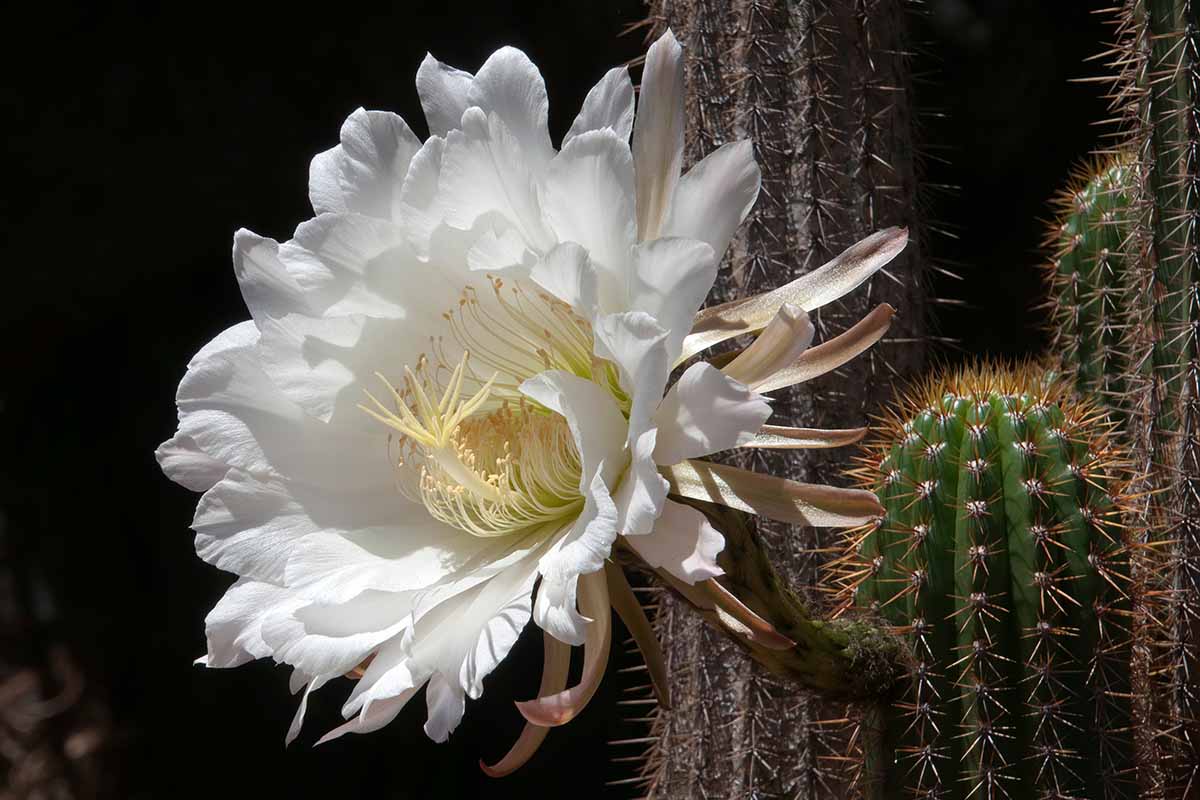
Its distinct flowers might invite some new wildlife into the nighttime garden and its gorgeous architectural shape will add interesting lines to your beds or greenhouse display.
The juicy, sweet fruits are typically harvested one month after pollination takes place.
Approximately the size of a tennis ball, each fruit is loaded with numerous glossy little black seeds.
Quick Reference Growing Guide
| Plant Type: | Cactus | Flower/Foliage Color: | White, pale lavender/dull green |
| Native to: | Northern Mexico, southwestern United States | Water Needs: | Low |
| Hardiness (USDA Zones): | 9-11 | Maintenance: | Low |
| Bloom Time/Season: | Spring | Tolerance: | Full sun, drought, herbivores |
| Exposure: | Full sun | Soil Type: | Gritty to sandy, nutrient poor |
| Time to Maturity: | About 35 years | Soil pH: | 6.0-7.0 |
| Spacing: | At least 15 feet | Soil Drainage: | Excellent |
| Planting Depth: | Soil surface (seed), root ball level with soil (transplants) | Attracts: | Bats, moths |
| Height: | Up to 26 feet | Uses: | Edible fruit, wildlife attractant |
| Spread: | Up to 12 feet | Family: | Cactaceae |
| Growth Rate: | Very slow | Genus: | Stenocereus |
| Common Pests and Diseases: | Mealybugs, scale, spider mites; root rot | Species: | Thurberi |
The Long and Short of the Lofty Organ Pipe
Pest resistant, sun-loving, and impervious to drought, organ pipe cactus is hardy and hassle-free. So long as you’re in the right climate, that is.
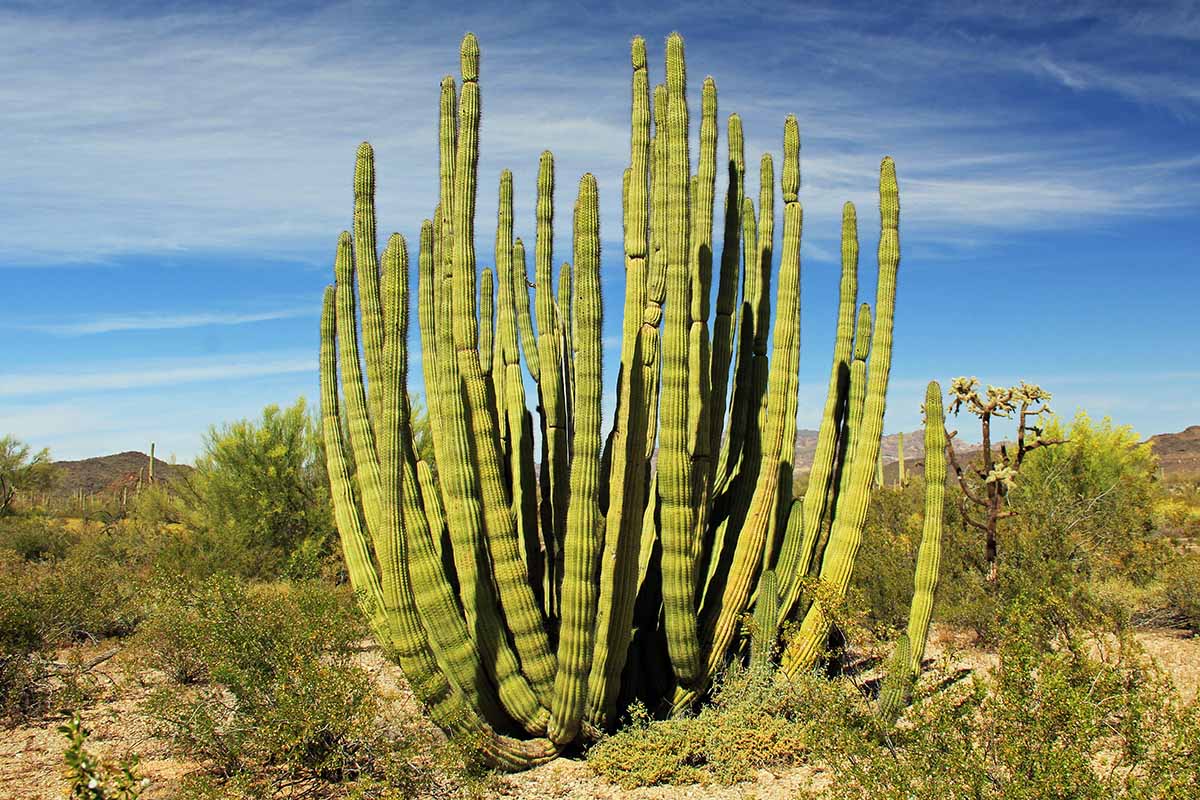
When setting up your organ pipe at home or in the garden, it will go a long way to think like a cactus and remember what these plants really want: hot, dry, and sunny conditions.
Keep these parameters in mind and you’ll have this titan of the desert growing for decades, maybe even centuries, to come.
Where does your organ pipe cactus grow? What tricks do you have to protect your cactus from frost? Let us know about your trials, tribulations, and triumphs in the comments!
For more reading on the organ pipe’s spiny and squishy cousins, check out these articles on growing cacti and succulents next:
